
| Production Output | 0.1-2 t/h |
| Power | Electric motor or diesel engine |
| Voltage | 110-415V |
| Raw Materials | Cereal, corn, wheat, soybean, etc |
| Type | flat die type |
| Final pellet size | 2.0 – 5.0 mm |
| Used For | pig feed |
| Brand | Victor |
pig feed pellet mill: High-temperature sterilization and high-starch gelatinization
As a specialized model within our versatile animal feed pellet mill series, the pig feed pellet machine is specifically developed for modern pig farms. It aims to simultaneously enhance biosecurity and reduce the feed conversion ratio (FCR).
Traditional powdered feed is prone to moisture absorption and carries pathogens, resulting in 5%-8% feed waste. Pelleted feed, through mechanical pressing and high-temperature maturation, significantly mitigates these risks. High-temperature pelleting (70–85°C) improves starch gelatinization, enhances energy utilization, lowers FCR, and reduces pathogens.
Meanwhile, the high-temperature pelleting process effectively reduces the load of common bacteria, lowering the incidence of respiratory diseases and intestinal stress, and the pig feed pelletizer machine is an important component of the pig farm’s biosecurity system.
For pig farms seeking stable feed intake, healthy growth, and feed conversion efficiency, this pig feed making machine is not just a pelleting device, but a key infrastructure for comprehensively improving production efficiency.
Why must pig farms use specialized pellet mills?
High-Temperature Conditioning for Sterilization: Prevention of African Swine Fever and Diarrhea
Pellet mills for pig feed can maintain a conditioning temperature of 80°C–90°C during the pressing process. Industry research has validated that this temperature range significantly reduces the activity of Salmonella, E. coli, and various heat-sensitive viruses.
Compared to raw feed powder, pelleted feed that has undergone high-temperature conditioning has a higher level of biosecurity and can effectively reduce the diarrhea rate in weaned piglets, making it a key step in improving biosecurity on pig farms.
Improving Starch Gelatinization: Adapting to the Monogastric Digestive System of Pigs
As monogastric animals, pigs digest cooked starch much more efficiently than untreated raw starch.
The high temperature and pressure during pelleting can increase the starch gelatinization of raw materials such as corn and soybean meal to 40%-60%, enhancing palatability and improving energy utilization, directly contributing to the production goal of reducing the feed conversion ratio (FCR).
Minimal Powder and Dust: Cutting Off Respiratory Transmission Routes
High-density pelleted feed has a powdering rate of less than 2%-3%, effectively reducing dust concentration in pigsties and blocking the transmission chain of respiratory pathogens.
Compared to powdered feed, pelleted feed helps reduce the incidence of respiratory diseases such as atrophic rhinitis and bronchitis, significantly improving air quality and overall health in pigsties.
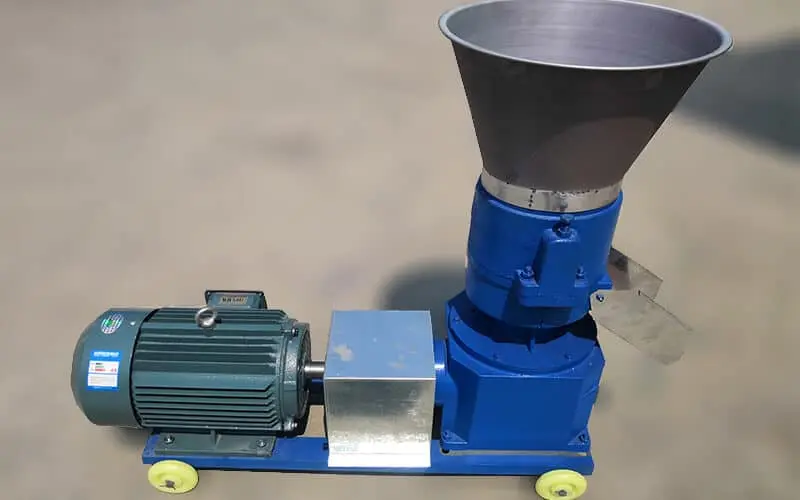

parameters of the pig feed pellet machine
Standard 3-5mm Medium Die Size
The pig feed pellet press machine comes standard with 3mm, 4mm, and 5mm medium-diameter dies to meet the physiological needs of pigs at different growth stages.
The 3mm–3.5mm die is suitable for piglets and nursery pigs, helping to improve swallowing speed and reduce feed waste; the 4mm–5mm die is more suitable for finishing pigs and sows, ensuring good palatability and stable intake. 4mm–5mm pellets are suitable for finishing pigs and sows, as the pellet size better matches their chewing strength and feeding speed.
This design directly addresses pig farmers’ core concerns about pellet size and nutrient absorption efficiency, making it a key configuration for upgrading pig farms to pelleted feeding.
Unlike the 8mm large-diameter die commonly used in cattle feed machines, pig feed pellets emphasize pellet fineness and digestibility, which is crucial for optimizing feed intake and reducing the feed conversion ratio (FCR).
Moderate Compression Ratio
Considering that pig feed mainly consists of concentrated feeds such as corn, soybean meal, and rice bran, and does not involve high-fiber straw, this pig feed pellet making machine adopts a medium compression ratio die structure.
The moderate compression strength produces pellets that are “compact on the outside and soft on the inside,” ensuring they do not break during transportation and feeding, while also allowing for rapid decomposition in the pig’s monogastric digestive system, improving starch utilization.
Industry data shows that a medium compression ratio can improve digestible energy (DE) utilization by 5%–12%, significantly reducing the fattening pig’s free flow rate (FCR). This optimized design ensures stable and efficient energy conversion and feeding performance for large pig feed pellet mills in commercial pig farms.
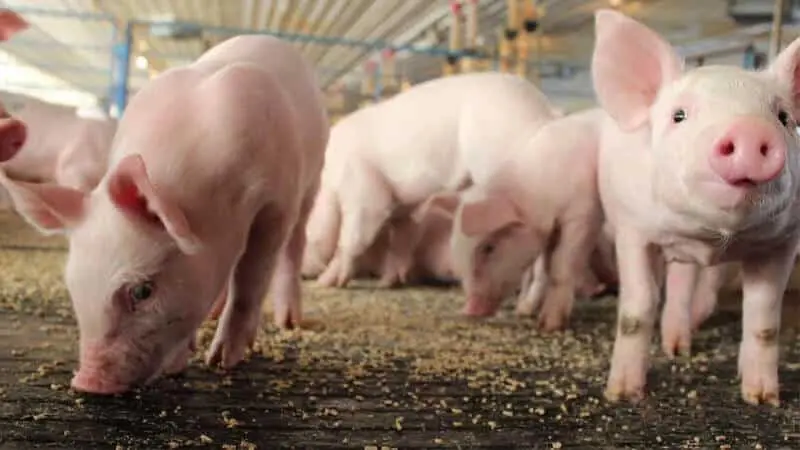
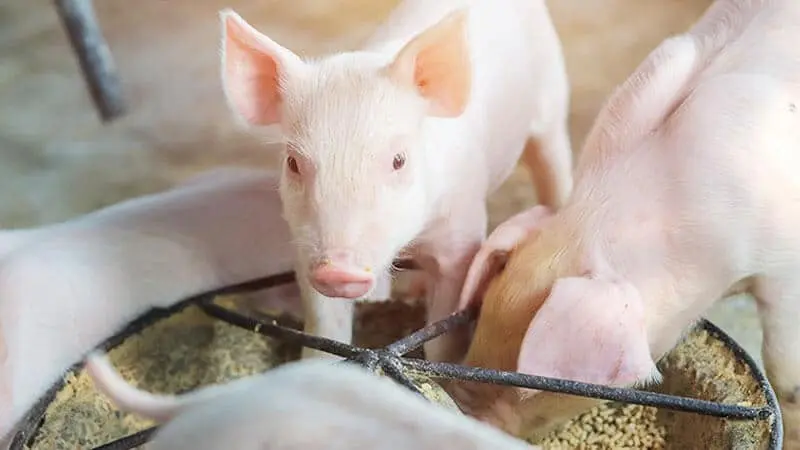
Pig growth stages and pellet size comparison table
To help pig farmers scientifically feed pigs at different growth stages, simply refer to the following pig feed pellet size diameter and feed recommendations.
This table not only clearly lists the recommended pellet sizes but also emphasizes pig feed pelletizer mill process requirements to facilitate high digestibility and pathogen control, meeting biosecurity and feed conversion ratio (FCR) management goals.
| Growth Stage | Pellet Size | Recommand raw materials | Pellet mill process requirements |
|---|---|---|---|
| Piglets/Creep Feed | 2.0mm – 2.5mm | High whey powder, easily digestible protein | Highly cooked to a crisp texture, ensuring adequate feed intake and digestion for piglets. |
| Piglets / Nursery Feed | 3.0mm – 3.5mm | Corn, soybean meal, premix | High sterilization requirements, prevention of diarrhea, and support for gut health. |
| Grower Pig/Finisher Pig | 4.0mm – 5.0mm | High-energy grains | Focus on pelleting speed and output, while maintaining pellet hardness and palatability. |
| Pregnant/Lactating Sows | 5.0mm – 6.0mm | High in fiber and balanced nutrition | The pellets have a moderate firmness, which increases satiety and ensures balanced nutrition for sows. |
Swine Feed Production video: 2-8mm Pellet
Economic Benefit Analysis: How can pelleted feed help you save money?
Feed Conversion Ratio (FCR) Improvement Data
Industry data shows that using pelleted feed can typically reduce the feed conversion ratio by about 0.2 (e.g., from 3.0 to 2.8), meaning that for every additional kilogram of pork produced, 0.2 kilograms of feed are consumed less.
For a farm with 500 pigs, this saving in feed costs is enough to purchase 2-3 pig feed processing machine within a year, directly demonstrating improved return on investment (ROI) and optimized operating costs. Investing in an automatic pig feed pellet machine further enhances efficiency and reduces labor costs.
Shorten the slaughter cycle
Pelleted feed, due to its high-temperature cooking process, high starch gelatinization, and low dust content, allows pigs to absorb nutrients more fully and reduces the incidence of disease.
Empirical data shows that pigs fed pelleted feed can be slaughtered 5-7 days earlier than those fed traditionally loose feed, accelerating capital turnover and further improving the economic benefits of pig farms.
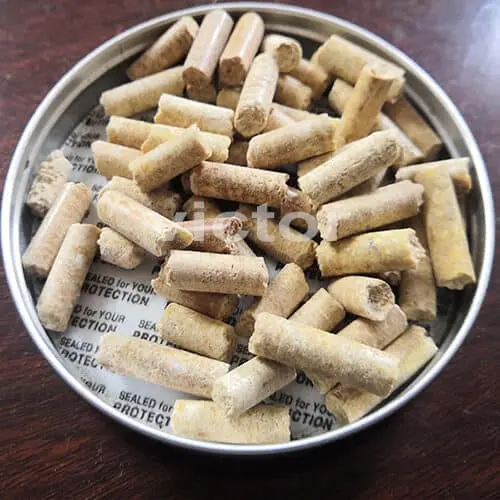
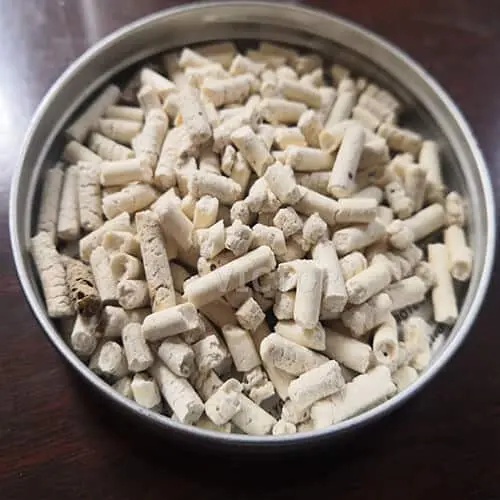
Diesel vs Electric Pig Feed Pellet mill specification
Electric pig feed pelletizer machines are suitable for farms with stable power supply, while diesel pig feed pellet machines provide flexibility for remote or mobile farms. Both types cover outputs from 0.1–2 t/h, allowing small and medium farms to choose the best pig feed pelletizer machine. Models such as the 500kg/h pig feed pellet machine and 1 ton per hour pig feed pellet mill are available depending on farm size.
Diesel pig feed pellet mill
| Model | Diesel Engine Power(HP) | Output(kg/h) | Weight(kg) |
| VTKLP-125 | 4 | 50-80 | 100 |
| VTKLP-150 | 5 | 100-150 | 150 |
| VTKLP-210 | 10 | 200-400 | 260 |
| VTKLP-230 | 15 | 300-500 | 350 |
| VTKLP-260 | 20 | 500-700 | 420 |
| VTKLP-300 | 25 | 700-900 | 650 |
| VTKLP-360 | 30 | 900-1200 | 900 |
| VTKLP-400 | 40-50 | 1200-1500 | 1200 |
Electric pig feed pellet mill
| Model | Electric Power(kw) | Output(kg/h) | Weight(kg) |
| VTKLP-125 | 3 | 50-80 | 80 |
| VTKLP-150 | 4 | 100-150 | 110 |
| VTKLP-210 | 7.5 | 200-400 | 210 |
| VTKLP-230 | 11 | 300-500 | 280 |
| VTKLP-260 | 15 | 500-700 | 300 |
| VTKLP-300 | 18.5 | 700-900 | 500 |
| VTKLP-360 | 22 | 900-1200 | 700 |
| VTKLP-400 | 30-37 | 1200-1500 | 900 |
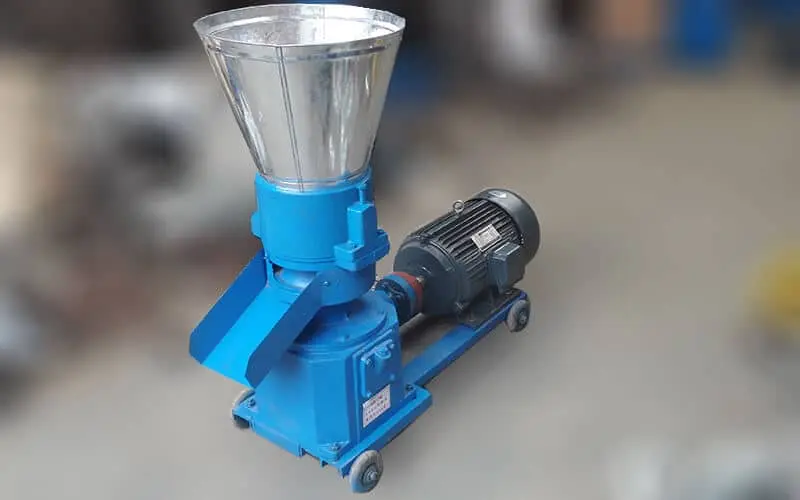
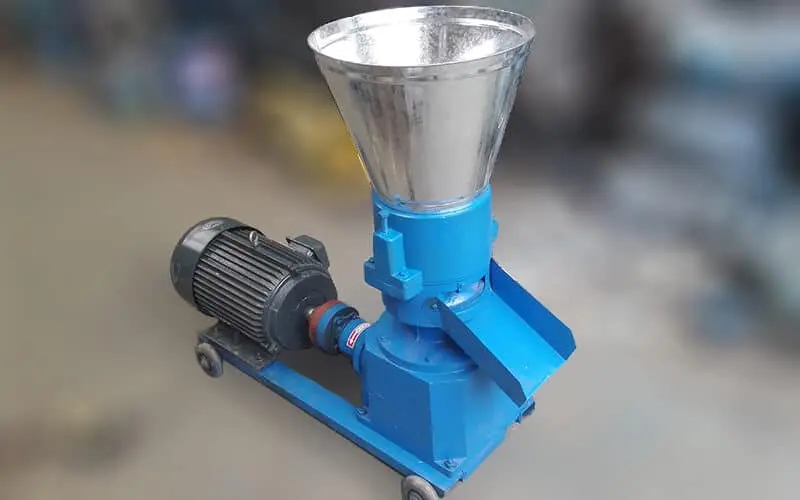
FAQ – For Pig Farm Operations
A: Yes, using a 2.0–2.5mm die, this pig feed pellet machine for home use or small farms can produce fine pellets to improve intake and digestion.
A: Yes, it can be added in moderation (max 15%-20%), as excessive moisture reduces pellet firmness and sterilization. Pigs mainly get energy and protein from grains.
A: Small flat die pig feed pelletizer machines suit family or small pig farms (<100 pigs) with low cost and simple operation.
Ring die pig feed pellet making machines suit medium to large farms, offering better sterilization and feed efficiency, though at higher investment.
A: Consider output, die size (2–8mm), power source (electric or diesel), and farm scale. The best pig feed pellet mill for small farms may differ from medium and large pig feed pellet mills. Always check pig feed pellet machine price and local availability.
